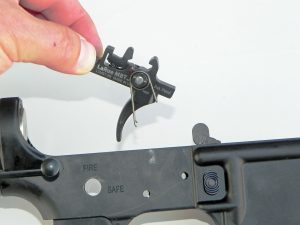The International Traffic in Arms Regulations, commonly known as ITAR, refers to the regulations surrounding shipping guns and ammo across national borders. However, companies such as Texas-based Defense Distributed are challenging that restrictive legislation by eliminating the need to cross international borders by producing firearms and firearm accessories in the United States through 3-D printing. For several years now, the company has been creating files that can be fed into a 3-D printer to produce fully functional AR-15 lower receivers (technically the gun, as I’m sure you know) and pistols1. Now, they are even manufacturing and selling entire CNC mills2 so that citizens can produce guns made at home without any BATF licensing and with no serial numbers.
Yes, this is legal, as long as you follow various rules as you do this. This is the next step forward from 80 percent receivers that can be turned into complete guns with a few drilling and milling operations and the addition of mail order parts. You can understand why the gun control crowd is terrified. Once this technology is widely distributed, gun control will be as practical and applicable as censorship is in the age of the internet.
The U.S. government cannot realistically control the sale of 3-D printers or CNC mills because too much of industrial civilization is dependent on them, and companies like Defense Distributed are doing their best to make sure anyone can buy a CNC mill. The Obama Administration was controlled by the billionaire gun control nuts and, while they would like to make the distribution of the files and other technical information about making your own guns illegal, they are limited by the First Amendment, except when they can attach it to international trade. Hence, ITAR comes into play.
Last year, the Obama Administration proposed changes to ITAR that would change the definition of the “technical data” that are subject to export controls to include “diagrams, models, formulae, tables, engineering designs and specifications, computer-aided design files, manuals or documentation, or electronic media3…” And the U.S. isn’t the only country concerned about this. The Australian state of New South Wales has criminalized “possessing digital blueprints for the manufacture of firearms on 3-D printers or electronic milling machines4.”
Clearly, the goal is to make it unlawful for Defense Distributed and others to distribute files and other “technical data.” While such a ban theoretically ends at the shoreline (because the internet extends planet-wide and even to space probes elsewhere in the solar system) a ban on exports actually means a general ban on putting this on the internet. In my opinion, even publishing a book in the U.S. might run afoul under the new ITAR standards. In this example, the book is published here, but anyone can buy the book and export it. Is the author in violation? What about the publisher or the person who bought the book and exported it?
What are the limits of that “technical data?” I think a good case can be made from a recent Steven Mathews’ article, “AR-15 Lower Shootout,” which qualifies as such when it explains that the spacing of the hammer and trigger pin holes in an AR-15 lower must be exactly .843" center to center5.
So, do you have anything to worry about? Perhaps. The Directorate of Defense Trade Controls (DDTC) has recently revised its regulations concerning ITAR, not on the 3-D printing subject, but on one of importance to anyone whose products might be exported or bought by the U.S. armed forces or who imports defense articles. The DDTC has the authority to require licenses from any company or individual who “engages in the United States in the business of manufacturing or exporting or temporarily importing defense articles, or furnishing defense services,” even if it is just a one-time event6. If you are a manufacturer, you may have to register with DDTC if you do any of the following7:
- Use of any special tooling or equipment upgrading in order to improve the capability of assembled or repaired firearms
- Modifications to a firearm that change round capacity
- The production of firearm parts (including, but not limited to, barrels, stocks, cylinders, breech mechanisms, triggers, silencers or suppressors)
- The systemized production of ammunition, including the automated loading or reloading of ammunition
- The machining or cutting of firearms, e.g., threading of muzzles or muzzle brake installation requiring machining, that results in an enhanced capability
- Rechambering firearms through machining, cutting, or drilling
- Chambering, cutting, or threading barrel blanks
- Blueprinting firearms by machining the barrel
The National Shooting Sports Foundation (NSSF) is concerned that the issue of the machining or cutting of firearms means that a gunsmith who threads a barrel might be required to register with the DDTC, which requires a $2,250 fee. Failure to do so for even one threading job could get you “huge fines and up to 20 years in prison8.”

Are you engaged in the business of manufacturing if you “use any special tooling or equipment upgrading in order to improve the capability of assembled or repaired firearms?”
Additionally, this where the 3-D printing files may be an issue. Assisting foreign persons in the design, development, and repair of firearms may constitute the export of a defense service (see 22 CFR § 120.9) and require ITAR registration with and authorization from DDTC. Also, exporting a firearm or any other item on the USML requires ITAR registration with and authorization from DDTC9.
You may be wondering if the First Amendment’s protection of free speech and freedom of the press take precedence. The U.S. Supreme Court has ruled that burning American flags10
and virtual child
pornography11 are protected free speech. Alan Gura, who has won many Second Amendment cases recently, is currently suing the Department of State on behalf of Defense Distributed on this very question12. Is technical information protected, especially if it is exported? Probably not. Some years ago, a publisher sought to offer a book about cryptography with two computer diskettes containing source code for encryption. The courts ruled that their export could be prohibited under ITAR as a defense article.13
As another example, some years ago a friend of mine and I wrote and sold (not very successfully) an encrypting program for PCs. One of the orders was to be delivered to the Norwegian Consulate in San Francisco. Fearful of violating ITAR, I contacted DDTC’s predecessor and asked if this required an export license. The answer was, “No, it isn’t leaving the U.S.” If transporting the computer program was an issue and we did so, the DDTC could impose some impressive fines and send you to prison. If you’re in doubt about whether you are potentially breaking the law, contact your attorney.
References
1. https://defdist.org/ last accessed June 23, 2015.
2. https://www.ghostgunner.net/ last accessed June 23, 2015.
3. Federal Register 80:106 31526 (June 3, 2015) http://www.gpo.gov/fdsys/pkg/FR-2015-06-03/pdf/2015-12844.pdf last accessed June 23, 2015.
4. J.E. Reich, “Owning A 3-D-Printed Gun File Is Now Illegal In Australian Province,” Tech Times, November 24, 2015.
5. Steven Matthews, “AR-15 Lower Shootout,” Shotgun News, June 20, 2015, 29.
6. Directorate of Defense Trade Controls, “Applicability of the ITAR Registration Requirement to Firearms Manufacturers and Gunsmiths,” July 22, 2016, 1, http://pmddtc.state.gov (PDF), last accessed August 9, 2016.
7. Ibid., 3.
8. National Shooting Sports Foundation, “NSSF Opposes Actions Forcing Gunsmiths to Register under ITAR,” August 9, 2016, http://bulletin.accurateshooter.com/2016/08/nssf-opposes-actions-forcing-gunsmiths-to-register-under-itar/, last accessed August 9, 2016.
9. Ibid., 4.
10. Texas v. Johnson, 491 U.S. 397 (1990).
11. Ashcroft v. Free Speech Coalition, 535 U.S. 234 (2002).
12. Defense Distributed v. U.S. Department of State, http://ia601509.us.archive.org, last accessed June 23, 2015.
13. Karn v. U.S. Dept. of State, 925 F.Supp. 1 (D.C.D. 1996)






